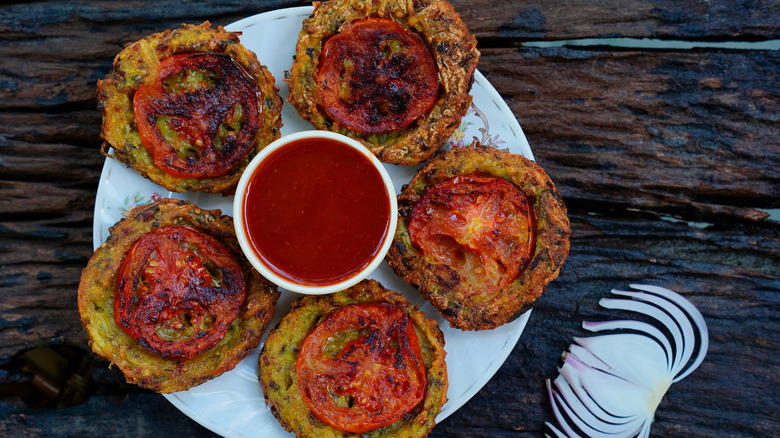What Makes Pakistan's Chapli Kababs Different From Others?
Kabab is an old traditional dish, it's arguably been around since humanity perfected the art of roasting meat, but the Royal Nawaab claims that officially, the original kabab was invented in the corner of the world we call Turkey today. Apparently, there is a record of the kabab in Turkey dating back to 1377. Animals were skewered and roasted over an open fire and some still cook kababs that way to this day.
In modern times, kababs have been made more accessible because they can be pan-seared or baked and are often served alongside bread, rice, or salad. Mutton, lamb, beef, goat, chicken, fish, and even turkey are all marinated in a wide variety of spices, herbs, and acidity (think lemon or vinegar) much like Greek gyros or Middle Eastern shawarma. With so many kabab variations, there are several different recipes we could dive into, but one of the most unique dishes is from Pakistan: the Chapli kabab.
History of the Chapli kabab
The Chapli kabab is one of Pakistan's most beloved dishes. This particular kabab was reportedly first created in Peshawar, in the northwestern corner of the country. NDTV Food says that the practice of cooking minced meat has been in the region since before the Mughal period. The method was created so that the meat of the dish would have a soft, tender texture. The Peshawar kabab, or Chapli kabab, is considered an authentic part of Pashtuni cuisine; born of the hands and minds of Pashtun people who are native to both Pakistan and Afghanistan.
Recipe52 tells us that "Chapli" is rooted in the Pashto word "chaprikh," meaning "to flatten," which should give you a pretty good idea about what this dish should look like. Popular in its native country and in the neighboring country of Afghanistan, the Chapli kabab is a thin patty of minced and heavily spiced meat.
It is super juicy and fatty and is made even more so by the addition of tallow and butter. The spices and other ingredients traditional to the Chapli kabab are dried pomegranate seeds, cumin, and coriander which are a particularly unique combination of flavors and textures meant to give the meat some complexity and crunch.
Ingredients
We brushed upon what the Chapli kabab is made of above, a flat, minced meat, spice, and veggie medley. But that doesn't even begin to touch upon the unique and cultural importance of the kabab's ingredients.
First and foremost, the most common kind of meat recommended online to make Chapli kabab is beef mince. Recipe Vibes suggests using shoulder cuts, brisket, short ribs, and shank for your minced beef, but also says that if you want a leaner cut of meat, something from the leg should do. Though recipes online often call for beef, Karakoram Restaurant says that lamb, chicken, and mutton are more popular in Pakistan.
Once you have your minced meat taken care of, it's time to look towards the spices and vegetables commonly mixed in. Migrationology tells us that there are a few variations of the Chapli kabab, but ultimately, some of the most common ingredients you will find chopped into the dish are tomatoes, onions, ginger, garlic, and chilies, which are added for some acidity and texture.
The flavor of the kabab is enhanced further by a mixture of fresh cumin, coriander, and garam masala. One ingredient that is particularly unique to the Chapli kabab is the dried pomegranate seeds, which are commonly added to give an extra crunchy characteristic and to add a little sourness to an otherwise rich dish (via Hungry for Goodies).
Chapli kababs vs. other kababs
Kababs are most commonly roasted on a spit or simply over an open fire, the meat (whatever that protein might be) is heavily spiced, and is sliced off in strips and eaten on sandwiches (think gyros and shawarma), or pieces are stabbed onto skewers (per Jamrah Restaurant).
But this particular Pakistani kabab is made much like a burger patty. It should have a satisfyingly browned outer crust holding a fatty, soft, and heavily seasoned center. Craving Zone says that the minced mix of the kabab is rolled together and flattened, then fried in olive oil, ghee, or butter, and served along with a side of chutney, tandoori chapatti, naan, taftaan, or rice.
Fatima Cooks explains that the Pakistani kabab tends to be softer in consistency than those in other nations. Another significant difference the Chapli kabab has is that they are much larger and thicker than other kebab meat, as big and juicy as an American burger. The addition of dried pomegranate seeds also sets this Pakistani dish apart.
This juicy kabab is quite popular in both Afghanistan and Pakistan, especially in towns and cities near the border. They are quite common as street food and are found in restaurants across both countries (via Tea for Turmeric).



